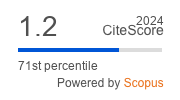Archaizing and Modernizing Strategies in Translation of the Texts in the 16-17th Centuries
DOI:
https://doi.org/10.29038/eejpl.2016.3.2.andKeywords:
translation strategy, archaization, modernization, neutralization of temporal distance, chronotope, artistic translation.Abstract
The article explores the strategies of rendering temporal distance in translation of classical texts of Shakespearian times. Archaizing, modernizing and neutralizing strategies are studied at language (stylistic), cognitive and pragmatic levels. Archaizing strategy lies in creating an image of a bygone epoch using archaic lexemes and grammar forms, literal rendering of cognitive scenarios and pragmatic formulas. Modernization is creating an image of modern time as part of chronotope of the integrative text concept, by selecting contemporary counterparts, sometimes with colloquial or vulgar stylistic characteristics, replacing the archaic cognitive scenarios and pragmatic formulas with modern ones. The strategy of neutralizing the temporal distance means eliminating time-markedness from the image of the artistic work.
References
- Baryshnikov, P. (2010). Metaphorical cognition and actualization of archaic concepts in the
daily discourse. Journal of International Scientific Publication: Language, Individual &
Society, 4(1), 152–159 - Bassnett, S. (2002). Translation Studies, 3rd ed. New York and London: Routledge,
2002. - Eco, U. (2000). Experiences in Translation. (A. McEwen, Trans.). University of Toronto
Press. - Hoyle R. A. (2008). Scenarios, Discourse, and Translation: The Scenario Theory of Cognitive
Linguistics, Its Relevance for Analysing New Testament Greek and Modern Parkari Texts, and
Its Implications for Translation Theory. Dallas: SIL International. - Izard, C. E. (1991). The Psychology of Emotions. New York: Plenum Press.
- Jakobson R. (2000). On linguistic aspects of translation (1959) In: The Translation
Studies Reader. (pp. 114-118)., L. Venuti, M. Baker, (Eds.). Routledge London and New
York. - Jones, F. R., & Turner, A. (2004). Archaisation, Modernisation and Reference in the
Translation of Older Texts. Across Languages and Cultures, 5(2), 159–185. - Kharmandar, M. A. (2014). Exploring archaism in translation theory and modern Persian
poetics: towards a Persian translation paradigm. Iranian Journal of Translation Studies, 12(46),
40–56. - Lefere, R. (1994). La traduction archaïsante: cervantes d’Après M. Molho. Meta, 39(1), 241–
249. - Malkki, A. (2009). Translating Emotions Across Time: Lewis Carroll’s Alice’s Adventures in
Wonderland. The Electronic Journal of the Department of English at the University of
Helsinki, 5. Retrieved from: http://blogs.helsinki.fi/hes-eng/volumes/volume-5/ translatingemotions-across-time-lewis-carroll’s-alice’s-adventures-in-wonderland-aila-malkki/ - MacDonald, P. S. Palaeo-Philosophy: Complex and Concept in Archaic Patterns of Thought /
MacDonald, Paul S. In Cosmos and History: The Journal of Natural and Social Philosophy.
Retrieved from: https://www.questia.com/read/1G1-170414880/palaeo-philosophy-complexand-concept-in-archaic - McElhanon, K. A. (2005). From word to scenario: the influence of linguistic theories upon
models of translation. Journal of Translation, 1(3). 29–67. - Steiner, G. (1998). After Babel: Aspects of language and translation, 3rd ed. London and
Oxford: Oxford University Press. - Schleiermacher F. (1992). On the different methods of translating In: Translation.
History. Culture: A Sourcebook (pp. 141–166). tr. and ed. A. Lefevere. London, New
York: Routledge. - Venuti, L. (1995). The Translator’s Invisibility: A History of Translation. London and New
York: Routledge.











 Creative Commons «Attribution» 4.0
Creative Commons «Attribution» 4.0